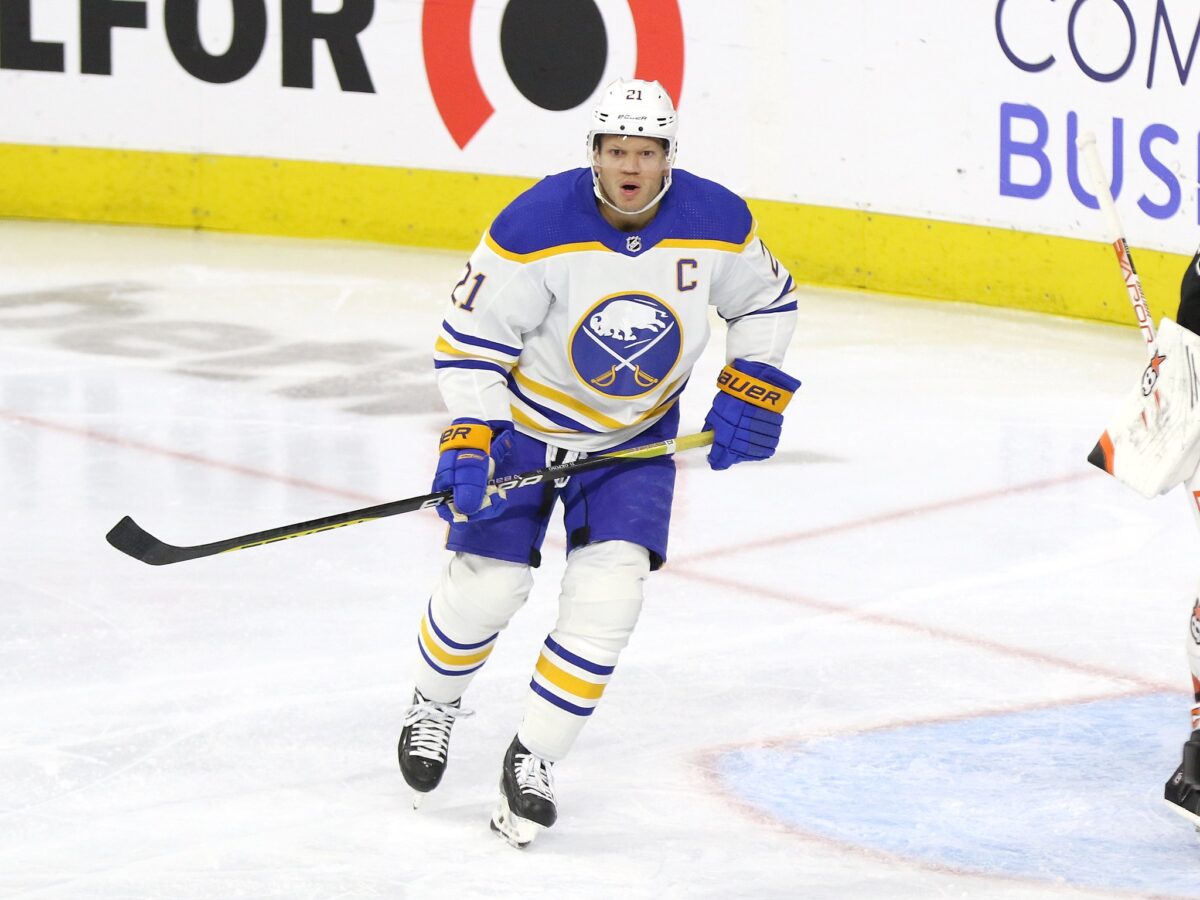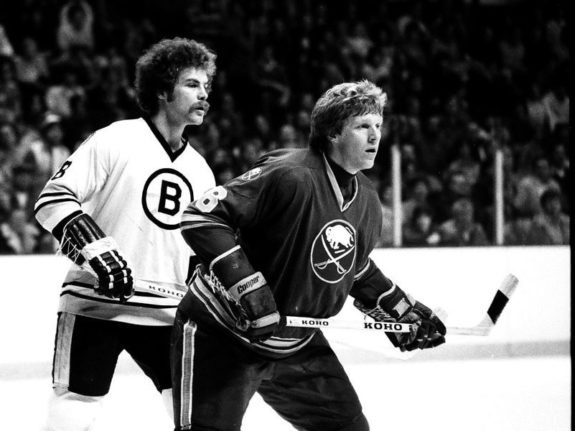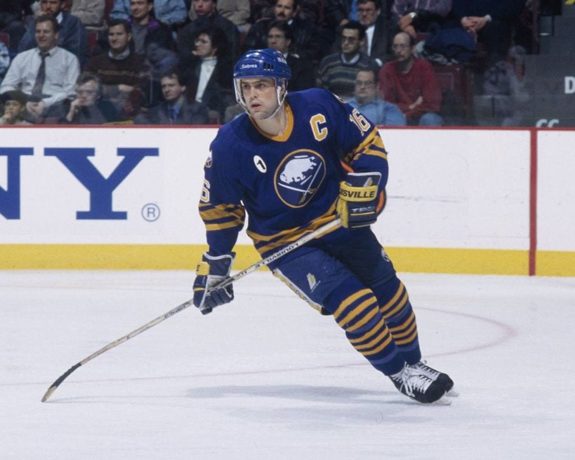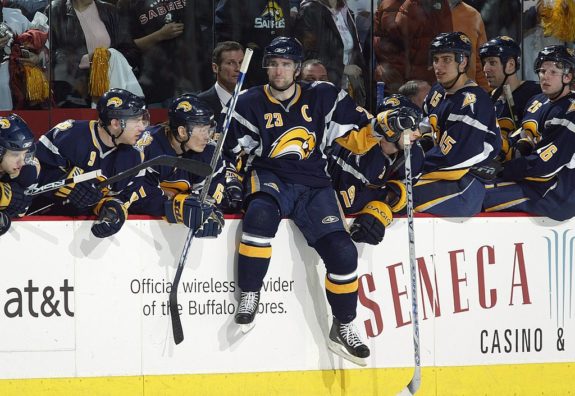Though technically nothing more than a formality, the role of captain is an essential one in the NHL and has been throughout its history. A captain is the leader of his team both on and off the ice and is also tasked with establishing accountability and discipline amongst his teammates. Since no team in the history of the sport has ever amounted to anything without strong leadership, it’s just as important as scoring and goaltending.
In the 53-year history of the Buffalo Sabres, 28 men have had the honor of the captaincy. Some tenures spanned multiple years while some were more brief, but regardless of length, each man to serve in the role made a contribution of some sort. Of them, the following five perhaps made the biggest impact.
It’s important to remember that, when assessing a player’s impact as the captain of his team, the primary criteria are leadership and character, not scoring and production. While it is true that most NHL captains are also their team’s best player, that’s not always the case and sometimes the biggest impact comes from someone who rarely appears on the scoresheet.
5. Kyle Okposo
Right off the bat, it may seem like a bit of a stretch to put Kyle Okposo on this list given that he’s only been the Sabres’ official captain for one season. However, though he only had the “C” put on his jersey this past year, he’s been the team’s leader for quite a while now.
In recent years, the Sabres have fully dedicated themselves to building around youth, a formula that has led to considerably improved results over the last two seasons. But while the team’s current roster is loaded with potential, it lacks experience. As a result, the few veteran players aboard are all the more essential, and none fit that description better than Okposo.

In the fallout of a disastrous 2021 season that eventually led to captain Jack Eichel being traded, Okposo emerged as the new leader of the team and helped lead a dramatic turnaround. The mentoring and guidance he provided to his numerous young teammates was highly evident and coach Don Granato rewarded his efforts by naming him the team’s new captain after it had been vacated the previous season.
The coming 2023-24 campaign will be a pivotal one for the Sabres, who are done wondering what they are capable of and will set out with their goals clearly defined. With their captain re-signed and leading the way, the team’s current chances are as good as any.
4. Jim Schoenfeld
Jim Schoenfeld was a force for the Sabres from the beginning and the epitome of a leader by example. After being drafted fifth overall in 1972, he quickly became one of the team’s most important pieces with his strong defense and rugged physicality, earning a formidable reputation for toughness and fearlessness. This was on full display on Dec. 13 1972 against the Boston Bruins (a team he famously hated). He and the Bruins’ Wayne Cashman collided and knocked open the Zamboni entrance of the Buffalo Memorial Auditorium, sparking a legendary melee.
Before the 1974-75 season, then-coach Floyd Smith (himself the team’s first-ever captain) stripped veteran Gerry Meehan of the captaincy and presented it to Schoenfeld on the cusp of his 22nd birthday. Never before had such a young player been given the honor and Schoenfeld became the youngest captain ever, a record that stood for over a decade. Such an unprecedented move may have been puzzling at the time, but Schoenfeld was the man for the job. That season the Sabres shocked the league and reached the Stanley Cup Final, thanks in no small part to their captain.

Though very young himself at that time, Schoenfeld was one of the biggest assets of the growing Sabres and he was the exact type of player they needed in the early years. His defense secured the back end of the ice and allowed the team’s offense to take off. But more importantly, he never shied away from a challenge and racked up 100-plus penalty minutes in four of his 11 seasons in Buffalo.
In spite of his contributions, Schoenfeld was stripped of the captaincy in 1977 when Marcel Pronovost took over behind the bench. He was traded to the Detroit Red Wings in December 1981 (ironically alongside Danny Gare, his successor) in a deal that brought back future team captain Mike Foligno. He coached the Sabres for one season after retiring and remains a revered figure in their history, having been inducted into the team’s Hall of Fame in 1995.
3. Gilbert Perreault
The strange thing about Gilbert Perreault‘s time with the Sabres is that, despite how valuable and natural of a choice for captain he was, he didn’t serve in the role until the tail end of his career. From the very beginning, Perreault was the center of the team (literally and figuratively) and no player since has been able to replicate his all-around offensive virtuosity. With graceful skating, remarkable dexterity and strong vision, he did it all for the Sabres and quickly established himself as one of the best players of the 1970s with his ability to both score and pass.
Flanked by fellow Franco-Canadians Rick Martin and Rene Robert, Perreault was the centerpiece of the famed “French Connection” line that had a considerable impact on the Sabres’ success throughout the eight seasons they played together. As a result, the team quickly rose to prominence and qualified for the playoffs seven times that decade.
The Sabres were hardly a three-man show during that period, however, and possessed a number of additional stars, but Perreault was always the most important piece and there was never any doubt that he was the cornerstone. But despite this, he didn’t become the team’s captain until the 1981-82 season, a role held until his retirement partway through the 1986-87 season. Though he served in the role longer than any other Sabre, he was passed over twice before finally receiving it, both times by younger players drafted in years after him.
It’s true that a team’s captain doesn’t have to be the best player and no one can deny that Schoenfeld and Gare were just as qualified. But since Perreault was synonymous with the Sabres throughout his entire career in addition to being highly respected by teammates and opponents alike, it’s a bit puzzling that he only spent seven of his 16 Hall of Fame seasons with the “C” on his jersey.
2. Pat LaFontaine
The second half of the 1980s was a strange time for hockey in Buffalo. Perreault’s exit in November 1986 left the team with a huge void and they eventually finished last in the NHL that season, receiving the first-overall pick of the draft for the first time since Perreault. Subsequent selection Pierre Turgeon helped turn things around, but the team’s postseason struggles from earlier in the decade returned and they were eliminated in the first round four consecutive seasons.
Then, in the fall of 1991, came a major shakeup. Turgeon was sent to the New York Islanders in exchange for the disgruntled Pat LaFontaine, who refused to report for that season after turning down a new contract. It was a bold move and while trading Turgeon was tough at the time, LaFontaine proved to be the better fit and instantly became the centerpiece of his new team. He found immediate chemistry with Alexander Mogilny and the two formed a lethal duo on the ice. Mogilny scored 76 goals and 127 points in the 1992-93 season while LaFontaine recorded 95 assists and 148 points.

But much more importantly than scoring, LaFontaine brought the Sabres back to life thanks to the energy and excitement he generated. The Detroit native was a consistent fan-favorite in his six seasons in Western New York thanks to his kind demeanor and numerous humanitarian efforts. He was also extremely popular among teammates as well and became captain in November 1992 after Mike Ramsey was traded. With him leading the way, Buffalo took off and finally made it to the second round in 1993 after a stunning sweep of the heavily favored Boston Bruins.
Struggles with injuries led to his departure in 1997 but his legacy endures and No. 16 was retired in his honor in 2006. He returned to the team as president of hockey operations in late 2013 but resigned just three months later, reportedly due to unhappiness with then-general manager Tim Murray. Unfortunately, that’s where his relationship with the franchise sits nearly decade later. Hopefully, the Sabres can find a way to mend fences with the Hall of Famer down the road.
Honorable Mentions: Danny Gare, Lindy Ruff, Michael Peca.
1. Chris Drury
In the summer of 2003, the Sabres franchise set out to resurrect itself after a tumultuous two-year stretch that saw them rescued from bankruptcy by a new ownership group. The front office decided on a complete overhaul and a number of longtime veteran players were shipped out in an effort to wipe the slate clean. One trade that July brought in Chris Drury from the Calgary Flames. It might not have seemed like much initially, but the move couldn’t have paid bigger dividends in the long run.
Despite his frustration at being traded for the second time in as many years, Drury and Buffalo proved to be the perfect match. Much like the team’s present situation, the revamped Sabres were loaded with talented young players but very inexperienced. Drury, a Stanley Cup champion and Olympic silver medalist, was the exact type of player they needed. Alongside Daniel Briere, acquired late the previous season, he immediately became the new face of the franchise. Both served as captain that season when it rotated on a monthly basis and they were named permanent co-captains the following year.

Both were essential to the Sabres’ sudden and remarkable revival in the two years that followed, albeit in different ways. Briere was a dynamic and consistent scorer while Drury was the revered leader. Make no mistake about it, Briere was every bit as essential and esteemed in his own right, but Drury’s stoic presence may have been more valuable in hindsight. He was universally admired in the locker room and set the example for his numerous young teammates to emulate. The respect he received was never more evident than when the team staged a full-on brawl in February 2007 after he was injured by a dirty hit.
Related: 3 Sabres’ Areas of Improvement to Make 2024 Playoffs
Unfortunately, this only served to make that summer all the more painful. Buffalo somehow allowed both of its co-captains to walk in free agency, a stunning turn of events that still has fans in disbelief 16 years later. Drury’s departure was particularly demoralizing, as it deprived the young team of the voice it needed the most and left it no choice but to find its own way in the years that followed. Briere’s departure was equally difficult, but scoring is far easier to replace than character. Not so coincidentally, the Sabres declined sharply in the years that followed and it’s safe to assume they’d like a mulligan on this one.
Who Will Be the Next Sabres Captain?
The future of the Sabres’ captaincy could be up in the air. Okposo signed a one-year deal to return for this season and there’s a good chance that it could be his last in the NHL. Buffalo has a number of candidates who could step up if that proves to be the case, most notably Rasmus Dahlin and Alex Tuch. Whoever is next to receive the honor will be tasked with keeping the team’s current upward trend going. Luckily, the team appears up to the challenge and whomever is named as Okposo’s successor should fit seamlessly.
